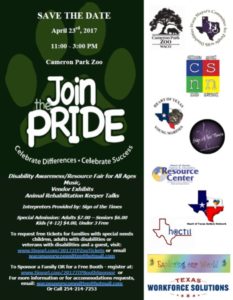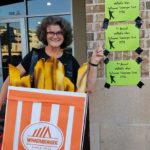By Bill Gaventa
This last weekend saw one of the most popular service events in Waco, the Really Big Fishing Event for very Special People. The pictures in the WacoTrib were great as was the effort and support put in by so many people and organizations in the Waco area”. But there is a “catch” here (so to speak) and one that is not meant to criticize the event at all. In fact, it is a positive illustration of the very point I wish to make.
The day of fun and service drew together people who often move in very separate worlds. One of the biggest issues for people with intellectual and developmental disabilities, as well as people with other disabilities, is the fact that social, cultural, and architectural barriers often limit their opportunities to participate fully in the kinds of activities many of us take for granted. On the other hand, many people we might call “non-disabled” don’t see or interact with people with disabilities on a regular basis, sometimes because the services and supports for them can separate them from typical settings, or because they stay at home with nothing meaningful to do.
Thus, we end up in a world where people who labeled “disabled” are often seen in one conceptual box, and people labeled “normal” are in another. The problem with these kind of labels is they take on far too much power by seeing a person only by one dimension of their lives. That’s not just a problem here: think now-a-days about political labels, racial labels, cultural labels, religious labels, sexual labels…the list can go on and on. Those labels prejudice what we see, because they fill a whole backpack of assumptions and expectations that we think are true about another person even before we know them. In her famous TED Talk, Nigerian novelist Chimamanda Adichie calls it “the danger of a single story.” Every one of us has experienced that from other people in a way that does not feel right or true to who we are.
Labels put people in boxes in the shelves of our minds. What we need, in so many ways, are bigger boxes into which two boxes labeled differently can fit. Hence the Really Big Fishing Event for Very Special People. The bigger box was fishing, an activity that people from all kinds of backgrounds enjoy. In fact, for avid fishermen and fisherwomen, the fact that some other people may love fishing but never have a chance to go fishing is the real tragedy or disability, not the other kinds of labels they may wear.
The potential power of this annual Saturday event might also lead to other opportunities for people who love fishing to find other ways to help people with disabilities who also love fishing to have more opportunities to do so. Not in big events, but rather in small boats, from the river bank, from the dock, opportunities where the fishing “box” helps tackle the stereotypes and fears we may have, and where people then build relationships and friendships that mess up our smaller boxes and more rigid labels.
 There are organizations around Waco making great strides in building those bigger boxes. Sports brings people together with many levels of ability in Special Olympics and No Limitations Athletics. The Arc of McLennan County uses country music, barbecue and a raffle auction to bring together people in the community who support individuals and families. The Autism Walk on Saturday, April 8 does the same as does art in several venues and programs. Join the Pride, an event on April 23, uses the great Cameron Park Zoo to do the same, as well as to celebrate people of all abilities at a zoo with a great reputation for its work in support of animals with one form of disability or another. The Waco Mayor’s Committee on Disabilities coordinates this upcoming event with sponsors who help the day to be free for people with disabilities and their families. Volunteers are both needed and welcome.
There are organizations around Waco making great strides in building those bigger boxes. Sports brings people together with many levels of ability in Special Olympics and No Limitations Athletics. The Arc of McLennan County uses country music, barbecue and a raffle auction to bring together people in the community who support individuals and families. The Autism Walk on Saturday, April 8 does the same as does art in several venues and programs. Join the Pride, an event on April 23, uses the great Cameron Park Zoo to do the same, as well as to celebrate people of all abilities at a zoo with a great reputation for its work in support of animals with one form of disability or another. The Waco Mayor’s Committee on Disabilities coordinates this upcoming event with sponsors who help the day to be free for people with disabilities and their families. Volunteers are both needed and welcome.
The events are all inspiring not only because of the commitment and excitement that runs rampant but also because they find bigger boxes into which we all fit. They are doubly inspiring if we all look for ways this can happen in everyday lives. So rather than seeing people with differences as labeled boxes on a shelf, every time we see someone as “other,” or “not like me,” could we not ask ourselves: “Gee, I wonder what bigger box we could both fit into.” They are not hard to find and not hard to build.
All we must do is start the conversation, reach beyond the boxes in which might find ourselves, introduce yourself, and ask questions about who they are, what they like to do, and the dreams they have. Ronald Reagan first designated March as National Developmental Disabilities Month. If you want to do something in March, any of these organizations can help you. But perhaps you already know some individuals or families where you can start. There is no telling how many labels (and bigger boxes) you will find that you share in common with someone sitting on the shelf with you.
 Bill Gaventa is an ordained Baptist minister currently serving as the Director of the Summer Institute on Theology and Disability and the national Collaborative on Faith and Disability. . Bill’s pastoral career has been in a variety of roles at the intersections of faith and disability, including community supports with people with disabilities, training for clergy, seminarians and community services staff, aging and end of life/grief issues in intellectual and developmental disabilities, cultural competence, and community building. He is currently serving as the President of American Association of Intellectual and Developmental Disabilities for 2016-2017. He and his wife Beverly moved to Waco in 2013 where she serves as Professor of New Testament Interpretation at Baylor University. In Waco, Bill serves on the Mayor’s Committee on Disabilities, the Board of the Arc of McLennan County, and the Professional Network Advisory Committee of the Heart of Texas Region MH/MR Center. You can email Bill at [email protected].
Bill Gaventa is an ordained Baptist minister currently serving as the Director of the Summer Institute on Theology and Disability and the national Collaborative on Faith and Disability. . Bill’s pastoral career has been in a variety of roles at the intersections of faith and disability, including community supports with people with disabilities, training for clergy, seminarians and community services staff, aging and end of life/grief issues in intellectual and developmental disabilities, cultural competence, and community building. He is currently serving as the President of American Association of Intellectual and Developmental Disabilities for 2016-2017. He and his wife Beverly moved to Waco in 2013 where she serves as Professor of New Testament Interpretation at Baylor University. In Waco, Bill serves on the Mayor’s Committee on Disabilities, the Board of the Arc of McLennan County, and the Professional Network Advisory Committee of the Heart of Texas Region MH/MR Center. You can email Bill at [email protected].
The Act Locally Waco blog publishes posts with a connection to these aspirations for Waco. If you are interested in writing for the Act Locally Waco Blog, please email [email protected] for more information.
By Courtney Restivo Wollard
As a follow up to a previous healthy blog post, I wanted to highlight one of the partners in the Healthiest Cities and Counties Challenge (HCCC) – The CenTex Hispanic Chamber of Commerce.
 Throughout the years, the Chamber has hosted free family funfests and women’s conferences during the month of February. This year, the event will focus on empowering women’s health, heart, soul, family, and home. It’s called the Hearts & Homes Ladies’ Conference. The event will include several vendor booths to provide information on resources to the community including career building and home buying assistance, home maintenance tips, and a wellness zone plus door prizes! Lunch and snacks will also be provided. Something new this year that the Chamber will offer as a partner in the HCCC will be providing a healthy traditional Hispanic meal cooking demonstration and food sampling during the event.
Throughout the years, the Chamber has hosted free family funfests and women’s conferences during the month of February. This year, the event will focus on empowering women’s health, heart, soul, family, and home. It’s called the Hearts & Homes Ladies’ Conference. The event will include several vendor booths to provide information on resources to the community including career building and home buying assistance, home maintenance tips, and a wellness zone plus door prizes! Lunch and snacks will also be provided. Something new this year that the Chamber will offer as a partner in the HCCC will be providing a healthy traditional Hispanic meal cooking demonstration and food sampling during the event.
If you didn’t catch the previous blog about the Healthiest Cities and Counties Challenge, I will briefly describe its importance for our community. This is a national challenge consisting of 50 other communities (Waco-McLennan County included) all working to improve the health of their residents in many different ways. Communities could choose to improve on one of five metrics including community safety, built environment, social/economic factors, environmental factors, and healthy behaviors. Some communities are focusing on improving asthma rates for children, others are working to prohibit smoking in vehicles with children, some working to improve physical activity opportunities, and some are working on improving wastewater management. Waco-McLennan County will be working on the healthy behaviors metric more specifically increasing healthier eating and consumption of fruits and vegetables. The top communities at the end of the two year challenge (which began October 2016) that show an improvement in their metrics compared to baseline data submitted could win prize money for the community between $25,000 and $250,000 for our community tier.
All of that to say, it is important that residents know how to cook meals in a healthier way and learn how to incorporate more fruits and vegetables into their daily diet. That is where our partner, the CenTex Hispanic Chamber of Commerce comes in. They will be hosting three healthy traditional Hispanic meal cooking demos and samplings throughout the two year challenge in order to educate community members on cooking their favorite comfort foods in a healthy way and in a way that tastes great. The Hearts & Homes Ladies’ Conference is where the first of the three cooking demos will occur. We are very grateful to have the Chamber join in this fun and healthy challenge and we challenge you to eat more fruits and veggies! Be sure to attend the event on February 25th 2017 at the Waco Convention Center in McLennan Hall from 10am-3pm so you can be a part of the Healthiest Cities and Counties Challenge!
 Courtney Restivo Wollard is a lifelong Waco resident who works as Public Health Planner at the Waco-McLennan County Public Health District and serves as Chair for Live Well Waco, the group working to decrease obesity rates under the Prosper Waco Health Committee Initiative. She is also an alumnus of the Waco Foundation LeadershipPLENTY Institute. Courtney graduated with her Masters of Public Health from Baylor University and right away began her career as a health advocate. She is married to Kyle, with whom she has two fur babies – a Chihuahua and a Labrador. Courtney hopes to continue to create healthier environments for McLennan County residents.
Courtney Restivo Wollard is a lifelong Waco resident who works as Public Health Planner at the Waco-McLennan County Public Health District and serves as Chair for Live Well Waco, the group working to decrease obesity rates under the Prosper Waco Health Committee Initiative. She is also an alumnus of the Waco Foundation LeadershipPLENTY Institute. Courtney graduated with her Masters of Public Health from Baylor University and right away began her career as a health advocate. She is married to Kyle, with whom she has two fur babies – a Chihuahua and a Labrador. Courtney hopes to continue to create healthier environments for McLennan County residents.
The Act Locally Waco blog publishes posts with a connection to these aspirations for Waco. If you are interested in writing for the Act Locally Waco Blog, please email [email protected] for more information.
By Janessa Blythe
When I was a kid, my parents placed a bookshelf next to my room and my brother’s room. Every night, we’d pick a book, pick a parent, and spend a little time in another world. I remember always reading Amelia Bedelia with my dad, fairy books with my mom, and Harry Potter with the whole family.
Because that was all I had ever known, I assumed that most children grew up in households that emphasized reading daily.
In the fall of 2015, I ran a small book drive as a part of a course I was taking at Baylor. I knew that children from lower-income households probably had fewer books than their more affluent peers, but did not realize how great that difference was. The books we collected were given to some of the children at Estella Maxey Public Housing Complex here in Waco. When I delivered the books, I heard over and over again from the volunteers, “These kids just don’t have books at home.”
It turns out that the research shows that children from low-income households tend to lack access to books, and have few books in their homes. The US Department of Education found that 61% of low-income families have no books at all in their homes (US Dept. of Education, 1996). One example of this is low-income neighborhood in Philadelphia, where the University of Michigan found that the ratio was 1 book for every 300 children (Neuman and Celano, 2001).
Lack of book access is a huge issue for many of the children in our country, and it affects them every day both in an out of the classroom. According to the Education Equality Index, 60% of students in Texas are eligible for free and reduced lunch. The socioeconomic status of these children indicates that they more than likely lack access to books.
This is a problem because not all learning happens at school; children are only there about 7 hours a day, and they are only in school 9-10 months each year. This becomes an issue for lower-income students, because they lack learning resources at home. A study by the RAND Corporation about the “summer slide” found that “results in reading show that middle-income students maintained achievement levels over the summer while high-income students improved and low-income students lost ground” (RAND, 2011). Low-income students lose ground because they have fewer opportunities to practice their reading, or improve their reading when they are not in school.
There are a number of reasons for the lack of books in low-income households. There are libraries, but they are often far away and parent’s either don’t take their children, or don’t know that they should take their children regularly. School libraries often don’t allow books to be taken home, and are often unavailable in the summer. Finally, books are expensive and are difficult for low-income parents to afford.
When children from lower-income households go home, they don’t have the resources they would need to continue learning.
Scholastic’s Family and Community Engagement Research Compendium from 2013 puts the argument for book access succinctly:
- Children from less affluent families do not perform as well on achievement tests compared with children of more affluent families.
- These gaps related to families’ socioeconomic status are present even before children enter school.
- Reading to young children is related to stronger subsequent academic achievement.
- Children in low-income families have access to fewer reading materials than children of middle- and upper-income families.
Their conclusion is that “the only behavior measure that correlates significantly with reading scores is the number of books in the home,” and that “the most successful way to improve the reading achievement of low-income children is to increase their access to print” (Scholastic FACE, 2013).
We spend millions of dollars each year on education in America, but not all learning happens at school. Mortimer J. Adler once said that “the principle cause of the learning that occurs in a student is the activity of the student’s own mind.” When a child picks up a book, and struggles to understand what the letters on the page are communicating, that child activates his or her mind and is learning. This learning is unaided by a teacher, but it is learning all the same.
If a child has no books in their home, in the many hours they spend there, there is no prospect of picking up a book and learning to learn.
 Janessa Blythe is a junior at Baylor University originally from Colorado Springs, CO. She is studying Great Texts, Political Science, and Classics in the University Scholars Program, and anticipates attending law school when she graduates in May of 2018. She hopes to eventually work in education policy. In her free time, Janessa loves to spend her time outside, especially on the trails in Cameron Park.
Janessa Blythe is a junior at Baylor University originally from Colorado Springs, CO. She is studying Great Texts, Political Science, and Classics in the University Scholars Program, and anticipates attending law school when she graduates in May of 2018. She hopes to eventually work in education policy. In her free time, Janessa loves to spend her time outside, especially on the trails in Cameron Park.
The Act Locally Waco blog publishes posts with a connection to these aspirations for Waco. If you are interested in writing for the Act Locally Waco Blog, please email [email protected] for more information.
by Jessica Shelton
It has been my experience that most people have at least one thing that really lights them up. Something that, when they participate in it or observe it, creates a feeling of joy in that person. Their emotions run high and they lose track of time. For some it is dance; for others it is art. For me, it is band.
I thoroughly enjoyed participating in band in junior high and high school, and I planned to continue with band in college. During summer orientation my college advisor told me that in order to take my major seriously I should limit extracurricular activities and focus on my studies. Based on that advice (which, by the way, is no longer considered to be “good” advice), I did not join my college’s band, and it is one of my biggest regrets. I played my trumpet a few times a year at my church, but not as part of a band.
Almost twenty years later, as I was preparing my classes for the beginning of the spring 2015 semester at MCC, I received an email from our Music Department inviting faculty and staff to join a new band that was forming that semester. Friday Band, as it was named, would be for MCC employees, students, and community members. I immediately knew I wanted to be part of this group.
I felt nervous as I approached the band hall on the first day of rehearsal. I had no idea what to expect. When I arrived, Sarah Harris, who was Director at that time, made everyone feel welcome. She helped us find our section and talked with us about how much we had played since high school and what part we wanted to try within our section. I saw a few familiar faces of MCC colleagues, but most of the musicians were community members and students. When everyone was in the proper place, we started to play. Even something as basic as that first warm-up scale sparked a bit of that old familiar feeling in me. It was immediately gratifying to play in a large group again.
Each semester, Friday Band meets for 90 minutes (on Fridays, of course) and rehearses between seven and nine pieces for a concert to be held at the end of the semester. The pieces vary widely in difficulty level and style, from pieces written for junior high bands to more traditional classical pieces. It has been very refreshing to have the opportunity to play new music every semester. Both Ms. Harris and our new Director, Jon Conrad, are very patient, and the rehearsal atmosphere is relaxed and fun. If we attempt a piece several times and we are not able to make it work, we move on to something else. By the end of the semester we are able to present our concert pieces proudly.
In the same way that the music varies widely, so too do the backgrounds and playing levels of the band members. There are musicians who had not picked up their instruments in the twenty (or more) years since high school, and there are musicians who played all throughout college and never stopped. There are college students in their late teens and early twenties, people who have retired, and every age in between. One of the best parts of being in Friday Band for me has been connecting with so many people through music. I sit next to people I otherwise never would have met, and we have bonded through playing music together. Each semester has a different combination of people; some familiar faces return and new ones join the group. It has been particularly nice getting to know the students, learning about their career goals, and discussing where they want to transfer. Some of the students play their principal instruments in Friday Band, while others sharpen their skills on a secondary instrument. Their musical abilities are impressive.
I have participated in Friday Band each semester since the beginning, and I will continue to do so as long as it is offered. As a working wife and mother, it is sometimes hard to justify spending time on something that is just for me, but I think it is important to make the time for something that I enjoy so much. I feel more connected to my MCC and Waco communities, and my children seem to enjoy attending the concerts and even listening to me practice. I am even hopeful that one day my husband will brush off the dust from his drumsticks and join the band with me. I am very grateful that this opportunity exists.
The fifth semester of Friday Band will begin on Friday, January 20th. If you are interested in participating, contact Director Jon Conrad at [email protected] or (254) 299-8220. Band members can sign up to take the class as credit, if desired.
 Jessica Shelton is a Licensed Professional Counselor and a Licensed Marriage and Family Therapist. She works at McLennan Community College as an Associate Professor of Mental Health/Social Work. In her free time she enjoys cooking, hiking with her family, and of course playing trumpet in the Friday Band.
Jessica Shelton is a Licensed Professional Counselor and a Licensed Marriage and Family Therapist. She works at McLennan Community College as an Associate Professor of Mental Health/Social Work. In her free time she enjoys cooking, hiking with her family, and of course playing trumpet in the Friday Band.
The Act Locally Waco blog publishes posts with a connection to these aspirations for Waco. If you are interested in writing for the Act Locally Waco Blog, please email [email protected] for more information.
By Caitlin Giddens
 If you’re looking for last-minute Christmas gifts, then you’re in luck. Santa’s Arts Market will be held on Saturday, December 17, from 12-4 p.m. in Heritage Square. After taking your free photo with Santa, shop from Waco’s finest arts and craft vendors— including Black Oak Art, featured in this week’s “Fixer Upper” — plus Waco Woodworks, Misguided Good Girls, Wood Burning by Marsha, E2 Creative, local jewelers, potters, painters and more.
If you’re looking for last-minute Christmas gifts, then you’re in luck. Santa’s Arts Market will be held on Saturday, December 17, from 12-4 p.m. in Heritage Square. After taking your free photo with Santa, shop from Waco’s finest arts and craft vendors— including Black Oak Art, featured in this week’s “Fixer Upper” — plus Waco Woodworks, Misguided Good Girls, Wood Burning by Marsha, E2 Creative, local jewelers, potters, painters and more.
This arts market is more than a shopping opportunity — it’s a collection of our community’s creativity and a celebration of Downtown Waco’s Cultural District designation. “This year has been all about artists coming together to support each other,” Fiona Bond, executive director of Creative Waco, said.
 This Saturday, you can shop for handmade Christmas gifts at the Waco Downtown Farmers Market from 9 a.m. to 1 p.m., and then come to Santa’s Arts Market to finish your shopping list. There will be a range of goods for sale, including leather, metal, pottery, canvases and more traditional paintings and prints.
This Saturday, you can shop for handmade Christmas gifts at the Waco Downtown Farmers Market from 9 a.m. to 1 p.m., and then come to Santa’s Arts Market to finish your shopping list. There will be a range of goods for sale, including leather, metal, pottery, canvases and more traditional paintings and prints.
Susan Sistrunk and Jesus Rivera, two local artists commissioned to create ornaments for the State Capitol Christmas Tree, will sell custom painted ornaments at the market. Sistrunk’s glitter-filled ornaments will feature five different landmarks in Waco. “The customer will choose the fill and the landmark, and the ornament will be painted upon request,” Sistrunk said. “They will each be signed and numbered for the occasion, making this an extremely limited edition.”
At Santa’s Arts Market, you’ll find a truly unique gift while enjoying live jazz music, cute carolers, treats from Pokey-O’s and the best hot chocolate in town. Bring your families and pets and celebrate our city’s creativity!
 Caitlin Giddens is a writer, an educator and an arts enthusiast. She enjoys instilling her love of literature and art in others. You can contact Caitlin at [email protected].
Caitlin Giddens is a writer, an educator and an arts enthusiast. She enjoys instilling her love of literature and art in others. You can contact Caitlin at [email protected].
The Act Locally Waco blog publishes posts with a connection to these aspirations for Waco. If you are interested in writing for the Act Locally Waco Blog, please email [email protected] for more information.
By Ellen Filgo
The Waco Diaper Bank has been around for a whole year! For those of you who haven’t heard of us yet, the Waco Diaper Bank is dedicated to providing diapers to Waco and McLennan County families in need. This past year we distributed over 35,000 diapers – that’s over 4000 little bottoms dry for a day. Last year, when the organization launched, I wrote about why it’s so important that babies and toddlers have access to a supply of clean diapers: without them, there are not only health risks, but there are barriers to childcare and lost days at work and school for parents. State and federal assistance programs don’t provide diapers. The cost of diapers is high, at roughly $80-$100 a month per child.
A few months ago, I attended the Diaper Banks in America conference, put on by the National Diaper Bank Network (of which the Waco Diaper Bank has just become a member). While there I heard many stories from people around the country who have started diaper banks in their local communities, prompted by the startling statistic that 1 in 3 families in America struggle to afford diapers. Being a part of a newer, smaller organization, it was great to hear from more established diaper banks about how they operate, what their budgets look like, how they apply for grants, about the types of programs they provide, the agencies they work with, how they market their message, mobilize their networks, etc. The conference gave me a ton of information to help grow the Waco Diaper Bank and serve more families in our community.
While giving diapers to families in need helps in the short term, diaper need is a larger problem. So while at the conference, we also heard from a California state representative, Lorena Gonzalez, who co-sponsored, with bipartisan support, a bill to eliminate the sales tax on disposable diapers. While it passed in the California Senate, it unfortunately met with a veto on the Governor’s desk. Nevertheless, she is vowing to continue the fight to support families in need. After her talk, I was eager to partner with other diaper bank leaders in Texas. Together, I hope to find sympathetic legislators who will address this issue here in Texas.
In the coming year, I hope the Waco Diaper Bank can serve the community by providing diapers and by advocating for larger changes. That’s how I would love for the Waco Diaper Bank to progress over this next year. If you would like to be involved, please contact me at [email protected].
One way to help out this December is to be involved with our 2nd annual December Diaper Drive. From December 1-14, we will be collecting diapers at locations around Waco. Last year the Waco community outdid itself in generosity, collecting over 28,000 diapers. Can we beat that number this year? I would love for you to help us reach that goal.
There are other ways to help as well! Are you planning on throwing a holiday party? Ask your guests to bring a package of diapers. Are you doing some online Christmas shopping? Consider our gift-in-kind wishlist. Are you evaluating your year-end giving? You can donate online to help the Waco Diaper Bank with the acquisition and distribution of diapers.
Waco has a lot of need, but Waco also has a lot of heart. Together, we can help babies and toddlers in our community.
 Ellen Filgo is a research librarian at Baylor and a Wacoan of 8.5 years. She loves living in Sanger-Heights with her husband, her stepson and her two energetic little boys. She has been known to get sidetracked researching the answer to a random question casually asked in a Facebook post.
Ellen Filgo is a research librarian at Baylor and a Wacoan of 8.5 years. She loves living in Sanger-Heights with her husband, her stepson and her two energetic little boys. She has been known to get sidetracked researching the answer to a random question casually asked in a Facebook post.
The Act Locally Waco blog publishes posts with a connection to these aspirations for Waco. If you are interested in writing for the Act Locally Waco Blog, please email [email protected] for more information.
By Alan Northcutt
Solar panels, also called photovoltaic cells, were installed on my roof around New Year’s Day 2016. Since that time my average electricity bill has been $3.13. In fact, for 3 of those months my bill was $0.00. Yes, $0.00. So I would like to share my amazing experience with solar energy through a practical overview applicable to Central Texas.
Cost. Although the exact price of a home solar system depends on multiple variables, I will provide a general example for illustration. Importantly, now is an excellent time to go solar in light of plummeting panel prices and available incentives. A 7.5kW system (producing about 850kWh per month) has an invoice price of approximately $25,000. If the home is within their service area, ONCOR’s generous incentive would lower the purchase price to $20,000. And at income tax time, the 30% federal tax credit of $6000 would further lower the final price to only $14,000. The average time to pay for a system with electric bill savings is 7 to 8 years. After that, the system generates income, through these lower or absent electric bills.
Obstacles. The primary requirement is that the roof be unobstructed by trees or other objects. (But if an obstruction exists, many installers erect ground based solar arrays in the customer’s backyard.) A south facing roof generates maximum energy, but is not mandatory. Finally, homeowners’ associations will often assert that rooftop solar is not allowed. Fortunately, this claim is false, and these associations are not able to restrict solar installations in Texas. In reality, solar panels are not an aesthetic detriment to the roof. Their sleek, black futuristic appearance is actually an improvement over mundane gray shingles.
Installation. Waco is fortunate to have an excellent, experienced local installer in Holtek Solar, my provider. One advantage of a local business is the rapid attention paid to any questions or problems. Another option is Freedom Solar, based in Austin, which offers a no money down plan, with monthly payments. Installation involves attaching the panels to the roof, attaching the inverter (converts DC to usable AC) to an outside wall, and wiring the system components, connecting to the existing electric service. The process surprisingly only takes a couple of days.
Operation. One delight of home solar is monitoring the function of the system. Through one’s computer or smart phone app, the system data is displayed: weather conditions; daily output graph; weekly, monthly and annual outputs; individual panel generation; and cumulative cost savings in dollars. And through net metering, the excess production during the sunny hours is credited by the grid provider, lowering one’s electricity bill.
Maintenance. With no moving parts, solar panels are essentially care free. If the data monitor does show an output drop from a given panel, a cleansing spray of water is corrective. But in 10 months of operation, my system has required no maintenance.
Rationale. In conclusion, the reasons to install rooftop solar are multiple:
- Once the system cost is recovered, monthly electricity bill savings represent income. Further, the systems are guaranteed to produce 80% of initial output for 25 years!
- Home value may increase 3 to 4% upon the addition of rooftop solar systems, according to a 2011 study by the National Bureau of Economic Research.
- Conversion of the world’s energy system to renewables is a race against time, to avoid climate change catastrophe. Installation of residential solar is a powerful contribution toward winning this race.
- The immediate lightening of one’s greenhouse gas footprint is a potent step to combat anthropogenic climate change.
- Decreasing the use of fossil fuel energy helps combat its serious health impacts, including lung disease, cardiovascular disease, and 30,100 premature US deaths per year.
“Sunshine is Nature’s hug and spirit breath to the earth,” wrote Terri Guillemets. I concur with this sentiment, and invite others to consider powering their homes with this limitless, clean, zero carbon resource.
 Alan D. Northcutt, M.D., is a local physician and director of the Waco Friends of Peace/Climate (www.friendsofpeace.org).
Alan D. Northcutt, M.D., is a local physician and director of the Waco Friends of Peace/Climate (www.friendsofpeace.org).
Justification. The reasons to install rooftop solar are multiple:
(WISD is working hard for the children in our community. Today’s blog post is the first in a series of five WISD innovations that every Wacoan should learn about and celebrate! — ABT)
Psst! Hey! Waco ISD eighth graders! Did you know that you can earn an associates degree, at no charge to you, BEFORE you graduate from high school?
Take a minute to absorb that statement. A college degree. No cost to you. Before you graduate from high school.
It may seem a little intimidating to start thinking about college classes when you are in eighth grade (or 9th, or 10th or 11th grade), but there are plenty of people at Waco ISD who want to answer your questions and help you succeed! Why not check it out? Dual credit could set you on a path that can save you a pile of college tuition money and open up all kinds of new opportunities for you.
If you were worried about how you were going to pay for a 2-year degree, you can do it while you are in high school at the district’s expense! WISD pays for your tuition and will even pay for the books and fees. Yes, you have to plan ahead and work hard. But, Yes, it’s very possible. If you were planning on earning a four-year degree (or beyond), then you can basically get the first two years for free. Who wouldn’t want to do that?
“What? What?” you say, “Why didn’t I know about this?” Well, it’s pretty new.
Up until June of 2015, dual credit options were much more limited – you had to be in eleventh or twelfth grade, and you could only take a maximum of two classes per semester. But, Texas House Bill 505, which was signed into law in 2015, removed the restrictions on dual credit courses and opened the door to allow school districts and colleges to use state funds to help pay for dual credit classes. Then, in November of 2015, Waco voters ratified an additional tax to support WISD; part of that money is earmarked to help pay for dual credit. Lucky for you, Waco ISD has taken full advantage of these two changes to offer you a treasure trove of dual credit opportunities. Your options include everything from taking a few classes here and there to completing an entire associates degree while still in high school.
Here are some of the possibilities:
- Accelerate Early Degree program – This is a big deal! If you enter this program in ninth grade you can graduate with both a high school diploma and any one of several associates degrees from MCC including the following: Allied Health, General Business, Information Systems and Applications, Criminal Justice, General Science (designed to transfer to a four-year degree), Liberal Arts (designed to transfer to a four-year degree).
- MCC + 1 Program – Through this program you can complete 18-23 dual credit hours during high school. This allows you to complete an associate’s degree within one calendar year at MCC. You don’t have to start this one until you are a junior.
- Advanced Manufacturing Academy (GWAMA) /Advanced Health Care academy (GWACHA) –In both of these programs, you can earn dual credit toward a degree or technical certificate from MCC or TSTC.
- Just take a few classes – Not sure you want to plunge into a whole degree or certificate program while you are in high school? You don’t have to. But, you might want to take just one or two dual credit classes. That is certainly a possibility as well.
Want to learn more about it? The Advanced Academic Services Department at Waco ISD is working with the Waco Foundation to offer some student/parent workshops to give you all the details. The next session is on November 29 and it’s all about dual credit: What it is, why it is beneficial, how to enroll, and key deadlines to make sure you have the opportunity to take advantage of all the possibilities open to you. The ACCELERATE Early Degree program will also be explained in preparation for the December 1 opening of the application window. Target audience: 8th graders, Freshmen, Sophomores, Juniors and their parents. Date: November 29. Time: 6:15-7:15pm. Location: Waco High School, 2020 N 42nd St., Performing Arts Center. Even if you can’t make the meeting, you can still get the information you need. Get in touch with Scott McClanahan at Waco ISD. Call 254-755-9473 or email [email protected].
Psst! Hey! Waco community! I’m sure I don’t have to tell you that people who earn a workforce certificate or college degree almost always end up making more money than people with a high school diploma or less. The question is not whether our young people need that higher level of education, but how we can make sure they get it. It’s a complicated question. Dual credit can certainly be part of the answer, and Waco ISD is one of the leaders in central Texas when it comes to making dual credit available to our students. It is an innovation we should all celebrate.
Some our Waco ISD students face many barriers to obtaining a degree or certificate, but for some it’s a matter of knowing the options available and having someone encourage them to take advantage of those options. WISD is doing its part to make dual credit options available – let’s do our part to make sure every student in Waco knows about the possibilities and has someone cheering them on and encouraging them to take advantage of all WISD has to offer!
 This Act Locally Waco blog post is by Ashley Bean Thornton, she works at Baylor, helps out with Act locally Waco, and facilitates the Waco Foundational Employment Network which is a part of Prosper Waco. She likes to walk and doesn’t mind at all if you honk and wave when you see her.
This Act Locally Waco blog post is by Ashley Bean Thornton, she works at Baylor, helps out with Act locally Waco, and facilitates the Waco Foundational Employment Network which is a part of Prosper Waco. She likes to walk and doesn’t mind at all if you honk and wave when you see her.
The Act Locally Waco blog publishes posts with a connection to these aspirations for Waco. If you are interested in writing for the Act Locally Waco Blog, please email [email protected] for more information.
By Kelsey Leigh Ervi
On November 15, I received a message from my father. He had forwarded me an email he received from the church I grew up in. The church that helped shaped my faith. The church I was baptized in. The church I committed to Christ in. The church I left in the spring of 2007.
The email that my father forwarded me was regarding the upcoming congregational discussion and vote on revising the church bylaws. Attached to the email was a document entitled “Welcoming and Affirming Statement Packet.” I knew immediately what that meant.
The church I grew up in has always been an open and inclusive place of worship. My parents neither of whom were of devout spirituality when I was a child, wanted to introduce my sister and I to God in a healthy and non-aggressive way. I think both of my parents saw the importance in allowing their children to discover their own beliefs and to navigate through faith in their own way and on their own schedule. This particular church provided that kind of environment and we all attended the church for many years. My journey through faith, however, was a rocky one. I stumbled on many questions and doubts, and in one area over and over again, an area that would go on to be the biggest journey of my life.
I have known I was gay since I was a young child, my earliest memories point to age 6. But it wasn’t until I was 12 that I fully understood that being gay was considered different. That there was a status quo I no longer met. It was also at 12 that I truly recognized what fear was. For a young gay person in a conservative Texas town in 2002, fear was undeniable. And my 12-year-old self struggled through bouts of depression and identity crises, which meant I would remain closeted well into my teens.
Growing up gay in church was difficult as there were many contradicting statements being thrown my way from person to person. Growing up gay in America was difficult too, but over the last few years, things have been getting a lot better. Most notably the historic Supreme Court ruling that declared once and for all that everyone deserves the right to marry the person they love. I was in my office at work when the ruling went public. The final paragraph of the opinion that Justice Kennedy issued is written on my bedroom wall and has been since June 26, 2015. It’s the first thing I see when I wake up in the morning and the last thing I see when I go to bed each night. It feels like a blessing.
In regards to the upcoming discussion and vote, I read through the “Welcoming and Affirming Statement Packet” in its entirety and was very moved by it. As I said, I’ve always known the church I grew up in to be accepting, but to see the words written and to read the commitment this church wants to make to me and my LGBTQ brothers and sisters is something to be celebrated.
I know there are some who are concerned with the implications of disconnecting from the Baptist General Convention of Texas or the Waco Regional Baptist Association and, perhaps more seriously, to those worried about the response from Baylor, I understand their concerns, but I also ask them to reflect on Colossians 3: 12-16.
“Therefore, as God’s chosen people, holy and dearly loved, clothe yourselves with compassion, kindness, humility, gentleness and patience. Bear with each other and forgive one another if any of you has a grievance against someone. Forgive as the Lord forgave you. And over all these virtues put on love, which binds them all together in perfect unity. Let the peace of Christ rule in your hearts, since as members of one body you were called to peace. And be thankful. Let the message of Christ dwell among you richly as you teach and admonish one another with all wisdom through psalms, hymns, and songs from the Spirit, singing to God with gratitude in your hearts.”
Striving for what is right is the good of the Earth and sometimes we have to remind others of that. I hope this church and other churches will adopt “welcoming and affirming statements” because it is what is right and good.
Even when those inside a church are accepting and affirming it is still important to have an explicit statement. Many members of the LGBTQ community assume that they would not be welcomed in church and many of them have been rejected from their friends and families. I have felt this at other churches, and people I once considered friends disavowed me because of this one trait that speaks to the very core of who I am. A trait that speaks to the very core of what I love about myself.
In light of recent events, I find myself mourning the potential loss of the blessing I have written on my wall and other liberties that still feel new. I, like many of my LGBTQ friends, are afraid of what’s to come and we will be seeking safe spaces and places with open doors and open arms. Our churches can be one of those places. The people of the church can make it so.
I will admit to you that I do not identify as a Christian. My decision to leave the church comes with many clauses, but my journey through faith did lead me to the ultimate belief that there is something bigger than myself and I will not attempt to know all the answers but I will do everything I can to ensure I live from a place of acceptance and respect. Two qualities of many that I find unwavering in my God. Your God and my God are alike in this, I think. My God is one of love, one of compassion. My God is open and inviting. My God is a really good listener. And my God believes we are imperfect beings whose curiosity and benevolence are two of our greatest strengths. I think your God is all of these things too.
 Kelsey Leigh Ervi is a Dallas-based multidisciplinary theatre artist. As a director, actor and playwright, Kelsey’s work has been highly regarded by various publications including The Dallas Morning News, Dallas Observer, TheaterJones, and D Magazine. Kelsey’s directing work is geared towards ensemble-driven texts, bare-bones storytelling, object-puppetry, and work of the queer voice. When she’s not working in theatre, Kelsey can be heard talking about it. In November of 2015, she joined forces with two other Dallas artists and launched the Little Big Scene Podcast, a monthly podcast which serves to promote the past, present and future of the Dallas-Fort Worth theatre community. She currently serves as Associate Artistic Director for WaterTower Theatre in Addison, TX.
Kelsey Leigh Ervi is a Dallas-based multidisciplinary theatre artist. As a director, actor and playwright, Kelsey’s work has been highly regarded by various publications including The Dallas Morning News, Dallas Observer, TheaterJones, and D Magazine. Kelsey’s directing work is geared towards ensemble-driven texts, bare-bones storytelling, object-puppetry, and work of the queer voice. When she’s not working in theatre, Kelsey can be heard talking about it. In November of 2015, she joined forces with two other Dallas artists and launched the Little Big Scene Podcast, a monthly podcast which serves to promote the past, present and future of the Dallas-Fort Worth theatre community. She currently serves as Associate Artistic Director for WaterTower Theatre in Addison, TX.
The Act Locally Waco blog publishes posts with a connection to these aspirations for Waco. If you are interested in writing for the Act Locally Waco Blog, please email [email protected] for more information.
By Bruce Huff
“Fined $50 For Littering!” This is the catalyst for the song “Alice’s Restaurant Massacre,” written, recorded and experienced by Arlo Guthrie in 1967 during the VietNam War, and played as a cult song on Thanksgiving Day, every year since without fail.
I’m not sure the song’s message means more to me as someone who enlisted in the military because of the threat of prosecution, or because the hero of the story got a littering fine of $50. I got over the enlistment pretty fast, but the littering… not so much! Mind you, I am not the tidiest person around, but I HATE LITTER! I’ll go out of my way if I see an accumulation of trash. We, have made this trash. We purchased every piece of McRib wrapper, every napkin, every sack to bag your lunch, the cardboard box that blew off the top of our trash truck, the cigarette butts thrown in the curb and stay. Somehow, all this trash we see is created. Somehow, all this trash never gets picked up. Somehow, a Christmas tree sits dead all year on the island at Valley Mills and Waco Dr. in front of the U-Haul store, since, yes, Christmas.
Multiple Sclerosis forced me to retire early as my balance and fatigue were playing havoc on my day-to-day activities. That gave me time to help my city: Waco, Texas. I was born here 64 years ago. Waco was trashy then….sadly, Waco is trashy now. Just look out of your window, Trash at the next traffic light. Trash right across mansions on Ridgewood Drive. Trash in our river. Trash in our river. Trash in our river….Every day I look around downtown, the highways, alleyways and neighborhoods where I saw trash, litter, open dumpsters…it’s so bad that when it rains, the Brazos River dumps literally tons of waste. Who cleans all this mess? For the past two years, I have been ambling along, with my cane or mobility scooter, in a vacant lot, along the river, or in neighborhoods picking up your trash, our trash.
Finally, I realized it was just senseless to do this on my own, so I went to City Council with my “Wild About Waco” tee shirt and proclaimed, “I am Wild About Waco but not wild about our trash!” Like magic, they tripled the budget for downtown cleanup! So this is how the wheels of government work! A friend asked if she could join me, so we brainstormed one day about how we could organize a group of Senior Citizens to show our community- to make a social statement. Then, Alice’s Restaurant came to mind and we decided to call ourselves the “Group W Bench.”
In the song, Arlo is sent for evaluation as he is a malcontent, arrested for littering. The induction center put him on the “Group W Bench” with all the other malcontents for creating a nuisance, and he was asked, “Son, are you moral enough to join the Army after committing your special crime” of littering… Littering?
Later on in the song Arlo belts out, “Let’s start a movement! Sing a bar of Alice’s Restaurant, then another…before too long the whole country will feel like I did way back then.” We are starting an anti-litter movement in Waco, Texas! Thanksgiving Day is the 49th Anniversary of Alice’s Restaurant Massacre. On the Saturday after Thanksgiving (November 26) The Group W Bench will assemble at Indian Springs Park Suspension Bridge to clean up part of our city, and events are planned to continue the vision. The City of Waco Director for Solid Waste feels public help is needed as the city doesn’t have the resources. Do we wait for funding, or do we set an example now? The movement has started in Waco! It’s time to change our attitudes about trash across the USA. What happened to “Give A Hoot, Don’t Pollute”? What happened to picking up trash, pennies, soda bottles and straightening a neighbor’s fence? LET’S START A MOVEMENT!
Please join us on the Group W Bench! We are a group of senior citizens, church groups, Baylor fraternities, disabled and misfits who will gather on Saturday, November 26 from 12-3 Waco Suspension Bridge to clean our streets, one at a time! And remember, “You can get anything you want at Alice’s Restaurant.”
 Bruce Huff has Multiple Sclerosis, is semi-retired and now an activist in Waco, Texas
Bruce Huff has Multiple Sclerosis, is semi-retired and now an activist in Waco, Texas
The Act Locally Waco blog publishes posts with a connection to these aspirations for Waco. If you are interested in writing for the Act Locally Waco Blog, please email [email protected] for more information.
